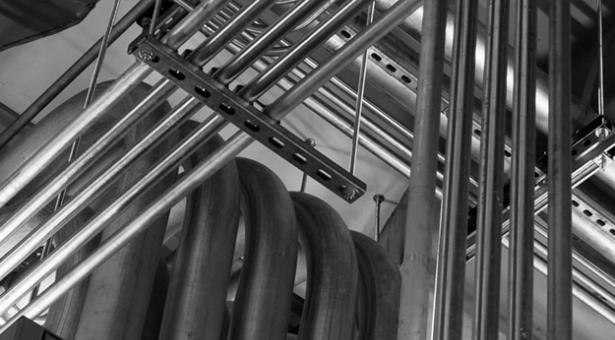

Primary Coolant Loop Simulation

The primary coolant loop runs through the Reaction Ignition Shield Thermal Modules (RISTM) and draws thermal radiation from the reaction. This has the secondary effect of cooling the modules and reducing thermal transfer to the chamber wall.
From the reactor, heated coolant is transferred to a Thermal Exchanger, where coolant from the secondary loop passes around the primary loop, allowing the transfer of thermal energy. The two loops remain isolated from each other to prevent the secondary loop becoming radioactive.
The temperature of the primary coolant is reduced as a result of the exchange, allowing it to be pumped back into the reactor to repeat the cycle.
Pumps maintain pressure in the primary loop to prevent coolant boiling at high temperatures (around 300°C). A drop in pressure will reduce the boiling point of the coolant. Should the coolant transition to steam, there will be a significant increase in pressure. Automated venting will occur to prevent damage to the thermal exchanger. This will have a significant impact on generation capability.
The primary coolant loop is treated as a single system by this version of the simulation. TRT input is averaged across all eight segments.
Future Expansion
To add greater realism, the primary coolant loop could be operated on a segment-by-segment basis, or even for each RISM thermal module.
Reactor Thermal Transfer
The primary coolant loop branches into a series of outlets which feed the Reactor Isolation Shield’s thermal modules. These modules contain a network of smaller pipes designed to maximise surface area for thermal transfer.
Thermal Transfer Rate (Thermal Flux)
The thermal radiation at the RIS is approximately 1500 degrees celsius, which is transferred to the coolant at an output rate (ie coolant temperature on exiting the reactor loop) of approximately 298 degrees centigrade.
Coolant flow rate is not a factor in thermal transfer to the primary loop because of the loop’s heavy pressurisation.
Function
Heat transfer is described by the function:
Where e is the entry coolant temperature (on entering the reactor chamber), r is the TRT and c is the transfer co-efficient (a constant of 0.162).
Coolant Vapour Pressure
The primary coolant loop is pressurised to prevent coolant boiling at transfer temperatures. At nominal coolant volume a pressure of 15.5Mpa is maintained which gives a coolant boiling point of 342 degrees celsius. This reationship between pressure and bolining point is referred to as vapour pressure.
A drop in water volume will result in a drop in pressure which needs to be compensated for by the pump.
Function
The vapour pressure (boling point) of the primary coolant is described by the function:
Where V is the boiling point (in degrees Celsius), P is the coolant loop pressure (in KPa) and t is the conversion factor from Torrs to Degrees Celsius (7.5). a, b & c are constants specific to the type of coolant liquid (in this case water):
a = 8.07131
b = 1730.63
c = 233.426
Coolant Pressure
A twin pumpset is used to pressurise the primary coolant loop. Each pump has the capacity to provide nominal pressure by itself. The pumps are run simultaneously at half capacity so that if one fails the other can automatically be increased to full capacity.
Pump Response Profile
The pumps have a linear response to power input, with 3100KPa of output per input unit.
Coolant Pressure
Coolant pressure is the output pressure of the pumps modified for the amount of coolant present in the loop. At nominal volume, coolant pressure is equal to the output pressure of the pumps. Lower coolant volume reduces pressure.
Function
Coolant pressure (measured in KPa) is described by the function:
Where p is the pump output pressure, vl is the volume of the coolant loop, vc is the volume of coolant in the loop and m is a system modifier (4650).
Thermal Exchanger Primary Interface
The primary coolant loop flows through the heat exchanger to transfer thermal energy to the secondary coolant loop, branching into series of smaller looped pipes to increase transfer surface area.
Thermal Flux from the primary interface (the thermal energy transferred) is calculated using the function:
where t is the incoming coolant temperature (the delta between incoming primary and secondary coolant temperatures), s is the surface area of the primary loop within the thermal exchanger (481m2) and c is a transfer co-efficient (which describes how efficiently the coolant loop’s material transfers thermal energy) which is a constant: 22 W/m2C.








